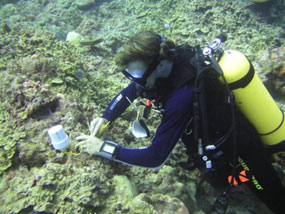| |
The coral reefs at War in the Pacific NHP (WAPA) are one of the most diverse ecosystems in National Park System. While final species inventories have not been completed for the park, WAPA's coral reef biologists estimate that over 3000 species of plants and animals live on park's reefs.
Coral reefs around the world are in danger of disappearing, and the reefs around Guam are no exception. Coral reefs around the world are being impacted by human activities such as fishing, coastal development, pollution, and global climate change. On Guam, the most significant threat to the health and survival of its reef is high sediment loads, or dirt running off land and onto the reef.
What are Coral Reefs?
Coral reefs are tropical marine ecosystems that support a high diversity of plants and animals. Because of their exceptionally high species diversity, scientists often refer to coral reef as the tropical rainforests of the oceans. The reefs in Guam are among the most diverse within US waters. A recent inventory of Guam’s reefs, documented over 5500 known species, and estimated that twice this number are yet to be described.
Corals form the foundation of coral reefs. Corals are animals that create calcium carbonate (CaCO3) -- or limestone -- skeletons, which form the matrix of the reef. At first glance, these organisms may appear to be rocks on the bottom, but they are alive. A thin skin of tissue overlays the limestone “rock,” and continues to deposit more CaCO3 so the coral can increase size. If the animal dies, the reef no longer grows, and over time, the remaining limestone skeletons will erode, eventually destroying the reef and the animals that rely on it.
Reef-building corals live in a symbiotic relationship with algae called zooxanthelle. This relationship is critical to the survival of the coral and the coral reef. The algae use sunlight to photosynthesize, and provide nutrition to the corals. Zooxanthelle also assist with depositing CaCO3. Without the zooxanthelle, reef-building corals could not survive.
While well adapted to surviving in the marine environment, certain conditions can put stress on the coral animal and reduce its ability to survive. Corals generally need clear, clean water. The temperature of the water is also very important, as most species can only survive in a narrow temperature range. Even though they are made of rock, many coral skeletons are brittle and fragile, and can be easily broken by waves, anchors or feet. Primary threats to Guam’s coral reefs include sedimentation, overfishing, pollution, and typhoons. In nearly every case, threats to Guam’s reef are linked to human activities on the island. The most significant threat to Guam’s coral reefs is sedimentation.
What is sedimentation?
Sedimentation is the accumulation of sediments, or dirt, on the reef. Sedimentation is a natural event and results from erosion of the land and reef. Areas with high natural sedimentation rates, such as river mouths, generally do have coral reefs.
High sediment loads kill coral in two primary ways. First, sediments can settle directly on top of corals and smother them. Corals are not capable of moving, and most coral have very poor mechanisms with which to remove sediments from on top of them. Second, sediments in the water affect water clarity, making the water cloudy or turbid. High turbidity reduces the amount of light that gets through the water column to the corals, and reduces the ability of zooxanthelle to photosynthesize.
Under natural conditions, most areas around Guam should have low levels of sedimentation. However, human activity has significantly increased the rate of sedimentation along many areas of the coastline, including along the coast within War in the Pacific NHP. These human activities are primarily related to poor land management practices, including urban development, unregulated use off-road vehicles and wildfires.
Wildfires and the demise of Guam’s coral reefs
Wildfires are a significant problem on Guam because the native ecosystems are poorly adapted to burning. Fires are not a natural occurrence on the island, and the vast majority of all wildfires are the result of human activity, mainly arson. Local hunters intentionally set fires to facilitate hunting pigs and deer, and in the process burn off vegetation, leaving the land bare and the soils exposed. Heavy seasonal rains wash the soils into Guam's nearshore marine environment and onto the coral reefs.
Fire statistics from the past ten years show that, on average, over 700 fires are set a year, burning as much as 15,000 acres of land. While this acreage is small compared to mainland US standards, 15,000 acres is equal to about 20% of the total area of the island. If a fire of similar magnitude was to occur on the mainland USA, the entire states of California, Oregon, Washington, Nevada, Arizona, Idaho, Montana, and Wyoming would be in flames, while about a third of states would burn in an average fire season. The repeated burning of the land from year to year has created a chronic erosion problem, particular on the southern half of the island where most of the burning takes place.
Within the park, it has been estimated that as much as 20% of the park’s land is burned every year. While this value may be on the high end, wildfires in the park are not uncommon. Between June-November 2003, two large fires occurred in the park, and that was during the island's wet season! Five to ten fires a year are not uncommon in the park, most occurring between March and June, during Guam's dry season. How much of this dirt winds up on the park’s coral reef is uncertain, but the biologists at War in the Pacific are conducting research to measure spatial and temporal patterns of sedimentation on the reef and determining the origin of those sediments so that the park can develop a strategy to reduce the effects of this impact.
What, Where, When and How Much
The Natural Resources Staff at War in the Pacific NHP is currently conducting a study to determine the spatial and temporal patterns of sedimentation on the park's coral reefs. This year-long project is measuring sedimentation rates at fifty sites along roughly two linear miles of reef using sediment collectors placed on the bottom at two depths (thirty and sixty feet). Sediment collectors are returned to the lab every twenty-one days and all collected dirt is dried and weighed. In addition to the dry weight, the percent of organic material and percent of carbonates is also determined using Loss on Ignition techniques. Sediment grain size is also determined. These descriptive measures allow the park staff to estimate how much of the collected sediments are coming off the land in runoff and how much are naturally occurring marine  derived sediments such as beach sand. derived sediments such as beach sand.
At each site, additional data collection is also planned (and is scheduled to begin in the coming months). This includes collecting basic water quality data (e.g. temperature and light availability), coral larval recruitment data, and an assessment of the coral reef community present at the study sites.
Field work and data collection on this project has been running for approximately months, and results are currently, too preliminary to draw conclusions. The park staff hope to have sufficient data by late summer to move into Phase II of their work, developing a series strategies to try and reduce sediment loads on the reef. This will most likely involve the development and implementation of a series of Best Management Practices (BMPs) to reduce upland soil erosion, runoff and sedimentation coupled with active land management and restoration. Without better land management, Guam's diverse and beautiful coral reefs may become a thing of memory.
Our Partners
A project of this scope and magnitude could not be accomplished with out the assistance of many people. Parts of the this project have received considerable support by way of in-kind services and goods from the Guam Department of Agriculture (Guam Division of Forestry and Guam Division of Aquatic and Wildlife Resources), Guam Bureau of Statistics and Plans, the University of Guam College of Life Sciences, Micronesian Divers Associations, and the Administrative, Maintenance, Interpretive, and Cultural Resource Divisions of War in the Pacific NHP.
|
|





